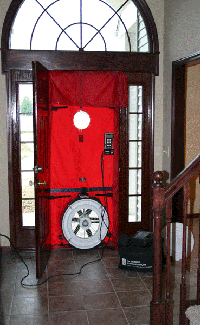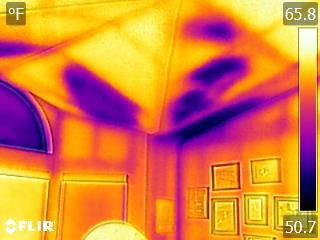Home Performance Diagnostics
The Home Performance Diagnostic is way more than just a simple energy audit. It is the doorway to our understanding your home's comfort issues and energy usage. We will tour your home to understand how you use it and the underlying building science to discover the reasons for your comfort complaints and where you are losing the majority of your energy, as well as all the while looking for safety and durability concerns.
- Step 1: Understanding Your Home
- Step 2: Taking a Tour
- Step 3: Blower Door
- Step 4: Infrared Camera Imaging
- Step 5: Test Heating Equipment Efficiency and Safety
- Step 6: Additional testing or inspections as necessary or desired
- Step 7: Create a Report
Step 1: Understanding Your Home
Before we can even begin our analysis, the first step is to understand how you use your home. After all, a doctor wouldn't diagnose you before asking you what hurts. In a similar way, our Home Performance Analysts, through training and experience, know to ask you the right questions to aid in their diagnosis. Where is your house coldest? What rooms do you spend the most time in? Have you recently put on an addition? All of their questions are going to shape how they perceive your house.
Step 2: Taking a Tour Inside and Outside
Next our Home Performance Analysts will tour your home with you to see where your complaint areas are located, make observations about the how the building was built, its' layout, and begin the measure your home to use later in our analysis. We start on the highest floor and progressively move down. We will use an Infrared Camera to help find any void in your insulation.
Step 3: Blower Door
The next step is using our blower door to find where your home is leaking. A blower door is a large calibrated fan that is placed in to an existing doorway in your home that simulates a 25 mph wind hitting your home from all sides. This test allows us to determine exactly how leaky is your home. We will continue this test by closing doors and checking for a pressure difference (Zonal pressure testing) and using a pressure pan to check for a pressure difference within the wall. All of this aids us in locating the many of the air leaks and prioritizing their repair. This test is also used to help highlight the effect building leakage has on your insulation performance.

Step 4: Infrared Camera Imaging
The next step is using our infrared camera in conjunction with the Blower Door to see, in real time, exactly where your home is leaking. The infrared camera can detect the heat flow from specific areas and helps our Home Performance Analysts to effectively look into the walls to find out how your insulation is performing. Air flowing through insulation defeats what it is there to accomplish. While this tool is helpful, it does need a temperature differential between inside and out. Therefore, we may need to run your heating or cooling system for a while to get the temperature difference.

Step 5: Test Heating Equipment Efficiency and Safety
Next, we'll use our tools to test your heating equipment for efficiency and safety. The national furnace minimum efficiency is 78% Annual Fuel Utilization Efficiency (AFUE), however, with a new efficient model, there are furnaces in excess of 90% AFUE.
Combustion Appliance tests are performed on gas furnaces, boilers, water heaters, and ovens to determine:
- The Combustion Efficiency of the Unit.
- Levels of Carbon Monoxide (CO) Gas in the units exhaust gases and in the air surrounding the appliance.
- Whether or not any exhaust gases are spilling into the home during use.
- The level of depressurization in the combustion appliance zone which can cause back-drafting and potentially a carbon monoxide poisoning or even a fire.
Step 6: Additional testing or inspections as necessary or desired
Next our Home Performance Analysts may bring to light an area(s) that need further investigation or you may decide to have us doHVAC Airflow & Efficiency Testing or Duct Leakage testing on your heating and cooling system. Neither of these type of inspections are included in our basic Home Performance Diagnostics.
Step 7: Create a Report
Now that we've collected all the information we need, the next step is to synthesize it and to make recommendations. Once all of the inputs are made we will generate a report with our recommendations and email it to you. Then we will setup an appointment so we can go through the report with you and answer your questions. Afterwards, if you have any more questions, you are encouraged to call so we can answer your questions.
